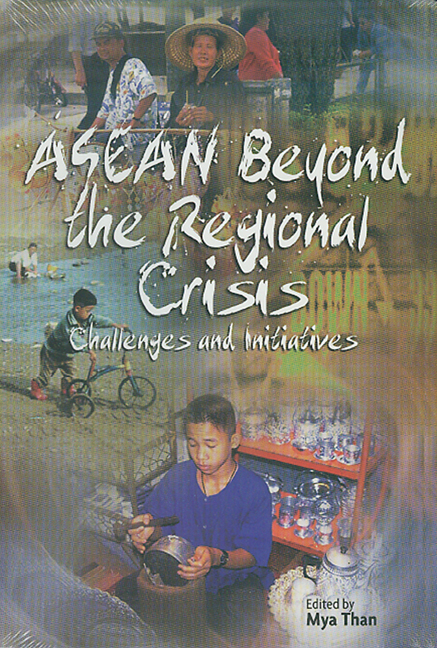Book contents
- Frontmatter
- Contents
- List of Tables
- List of Figures
- Glossary
- Contributors
- 1 ASEAN Beyond the Crisis: A Bird's-eye View
- 2 East Asia: Crisis and Recovery
- 3 Competitiveness and Sustainable Growth in ASEAN
- 4 ASEAN Free Trade Area: Progress and Challenges
- 5 ASEAN Investment Area: Progress and Challenges
- 6 Financial and Macroeconomic Co-operation in ASEAN: Issues and Policy Initiatives
- 7 Food Security in ASEAN
- 8 ASEAN Co-operation and the Environment
- 9 ASEAN and the International Trading System: Regional Trade Arrangement vs. the WTO
- 10 ASEAN and Its Inter-Regional Economic Links
- Appendix I ASEAN's Relevance: Has It Become Questionable?
- Appendix II Is ASEAN Still Relevant? Some Thoughts from a European Perspective
- Index
4 - ASEAN Free Trade Area: Progress and Challenges
Published online by Cambridge University Press: 03 November 2017
- Frontmatter
- Contents
- List of Tables
- List of Figures
- Glossary
- Contributors
- 1 ASEAN Beyond the Crisis: A Bird's-eye View
- 2 East Asia: Crisis and Recovery
- 3 Competitiveness and Sustainable Growth in ASEAN
- 4 ASEAN Free Trade Area: Progress and Challenges
- 5 ASEAN Investment Area: Progress and Challenges
- 6 Financial and Macroeconomic Co-operation in ASEAN: Issues and Policy Initiatives
- 7 Food Security in ASEAN
- 8 ASEAN Co-operation and the Environment
- 9 ASEAN and the International Trading System: Regional Trade Arrangement vs. the WTO
- 10 ASEAN and Its Inter-Regional Economic Links
- Appendix I ASEAN's Relevance: Has It Become Questionable?
- Appendix II Is ASEAN Still Relevant? Some Thoughts from a European Perspective
- Index
Summary
ASEAN Free Trade Area (AFTA) in Retrospect
ASEAN Economic Co-operation Before AFTA
Since the establishment of ASEAN in 1967 by the five founding members — Singapore, Malaysia, Indonesia, the Philippines, and Thailand — the political view was carried through as the centre of co-operation for a decade. During the early days of the establishment of ASEAN, there were a number of factors causing political instability in the region, including an ideology revolution, internal tensions, conflicts between some countries in the region, tensions arising from the Vietnam War, as well as the threat of an expansion of communism. Hence, the formation of a regional grouping was a means of solving conflicts among members and to sustain peace within the ASEAN region. “At that time, political instability in the region was the driving force behind ASEAN, and it has been argued that much of the attraction of regional economic integration was merely its use as a ‘cover’ for political cooperation, in particular, vis-á-vis instability in Indochina.”1 Later, economic co-operation was promoted in the mid-1970s, at the first two summits.
Co-operation among the ASEAN members during the first decade (1967–76) was clouded by differences among them. The progress of integration was significantly slow except for a number of political agreements. At the end of the Vietnam War in 1975, the ASEAN countries were concerned about the spread of the Marxist-Socialist system. This led to the first summit in Bali, in 1976, with the aim of strengthening co-operation in the region. The main discussion at the first summit still focused on political co-operation but a few points on economic collaboration were included, which became the framework for trade co-operation and led to the establishment of the Preferential Trading Arrangement (PTA) to stimulate trade among the ASEAN members.
The Preferential Trading Arrangement, launched in 1977, was the principal instrument for economic co-operation. The PTA was applied to basic commodities by providing preferential tariff rates, or margin of preferences (MOP). There were weaknesses in the implementation, resulting in difficulties in increasing intra-ASEAN trade. In the early stages, the MOP was applied as a product-byproduct scheme with an exclusion list including important products that had high trade values. The MOP started at only 10 per cent for products that were either wholly produced in ASEAN or with local content of at least 50 per cent in value.
- Type
- Chapter
- Information
- ASEAN Beyond the Regional CrisisChallenges and Initiatives, pp. 48 - 79Publisher: ISEAS–Yusof Ishak InstitutePrint publication year: 2001



